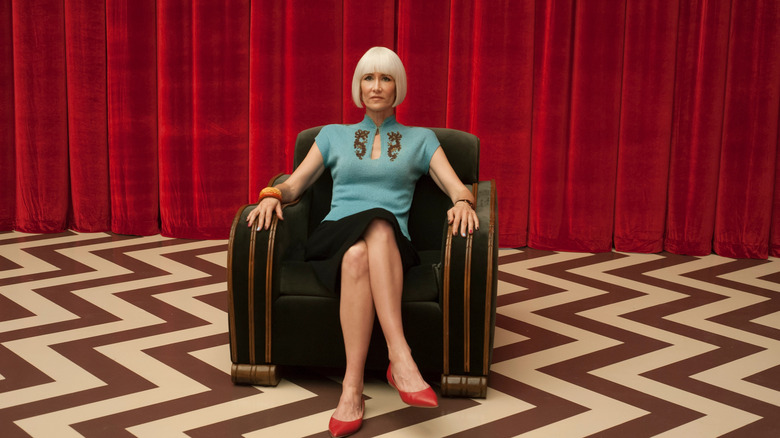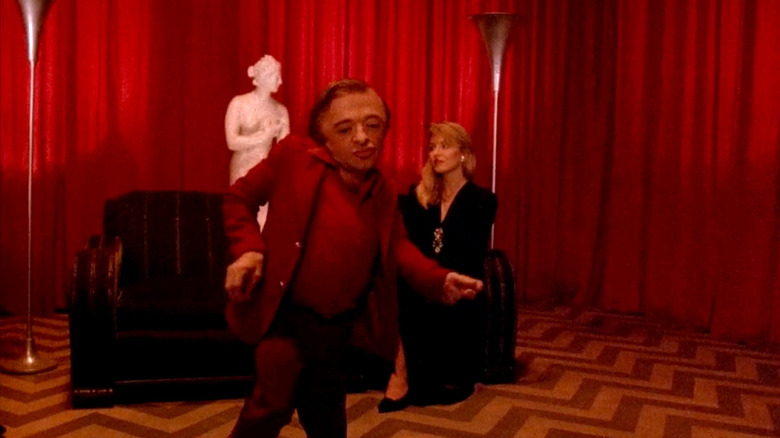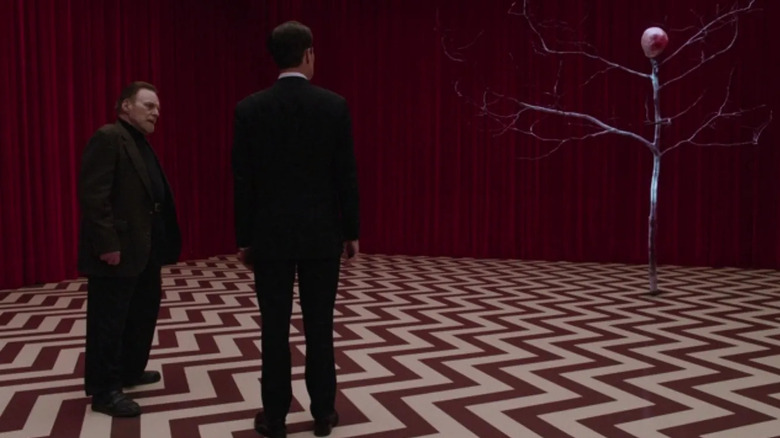Twin Peaks' Red Room Was Created To Serve A Surprisingly Practical Purpose
"Twin Peaks" first aired in 1990 and became an instant hit, even as network executives weren't really sure what to make of the show. According to series co-creator Mark Frost, the people running ABC were baffled by the pilot episode and were reluctant to air it — that is, until test audiences responded way more positively than they expected. "It blew away their expectations, and Bob [Iger] recognized we had something different," Frost told Yahoo Entertainment.
One of the things that made "Twin Peaks" so memorable was its many strange, dreamlike, ambiguous scenes. Serving as the inspiration for later hits like "Lost," "The Leftovers," and the dream-sequence episodes of "The Sopranos," to name just a few, "Twin Peaks" was one of the first shows on primetime television to make a conscious choice not to explain everything going on. David Lynch and Mark Frost weren't afraid to make audiences feel confused now and again, and the Red Room serves as a prime example of that.
The Red Room
The Red Room first appeared at the end of the second episode of "Twin Peaks." FBI agent Dale Cooper (Kyle Maclachlan) falls asleep in his hotel room and wakes up in a room walled in by red curtains. There's a strange marble statue of a woman behind him, and a man in red clothing sitting on the chair next to him. In the Red Room, everyone talks in a strange way that requires subtitles to understand. This was achieved by having the actors say their lines backward and reversing it in the edit.
A version of Laura Palmer (Sheryl Lee) soon shows up and whispers something into Dale's ear. When Dale wakes up he immediately calls Sheriff Truman (Michael Ontkean) and says he knows who killed Laura Palmer, and tells him to meet him for breakfast tomorrow morning so he can reveal his findings. Audiences waited a whole week in suspense, only for the next episode to open with Cooper saying he couldn't remember. I can only imagine how annoyed viewers must've been at the time, but it serves as an effective (if very harsh) reminder that solving the mystery of who killed Laura Palmer isn't the main point of the show. In fact, Lynch didn't even want to solve the mystery at all.
However, the realities of network TV at the time forced them to not only figure out who the killer was straightaway, but to film an alternate version of the pilot episode for European audiences, one where the killer was revealed and it would work as a stand-alone feature. It was this kind of studio meddling that led to the Red Room's existence in the first place.
Rolling with the punches
As Mark Frost told Yahoo Entertainment:
"The Red Room came about because when David [Lynch] did the pilot, our foreign distributor wanted to have a closed ending that they could release as a feature in Europe in case the show didn't get picked up for a series. So it was that scene that led to the discovery of Bob, the phrase "fire walk with me," and the first time we saw Michael J. Anderson as well. We had written the sequence into the second episode, and David's visualization of it became one of the most iconic images in television history."
Although the introduction of the Red Room and these other elements were not strictly organic storytelling choices, they did all ultimately become an integral part of what "Twin Peaks" would mean to millions of viewers, even 30 years later.
Although the ratings of "The Return" were a fraction of what they were at the original show's peak, its use of the surreal and the unexplained have given "Twin Peaks" one of the most passionate fanbases in TV history, and its traces can be found in a lot of other acclaimed shows. And as memorable as the characters, mood, and setting of the show were, whenever I hear someone mention "Twin Peaks," those red curtains are the first thing to come to mind.


